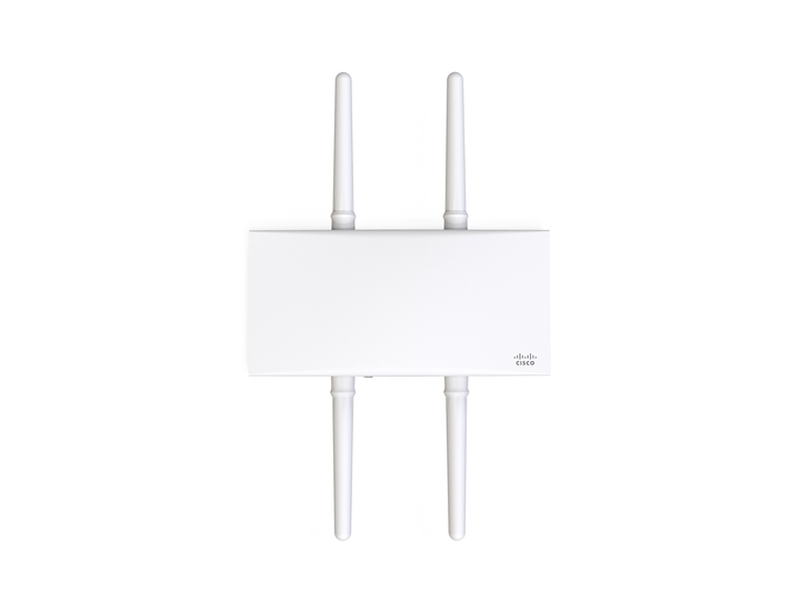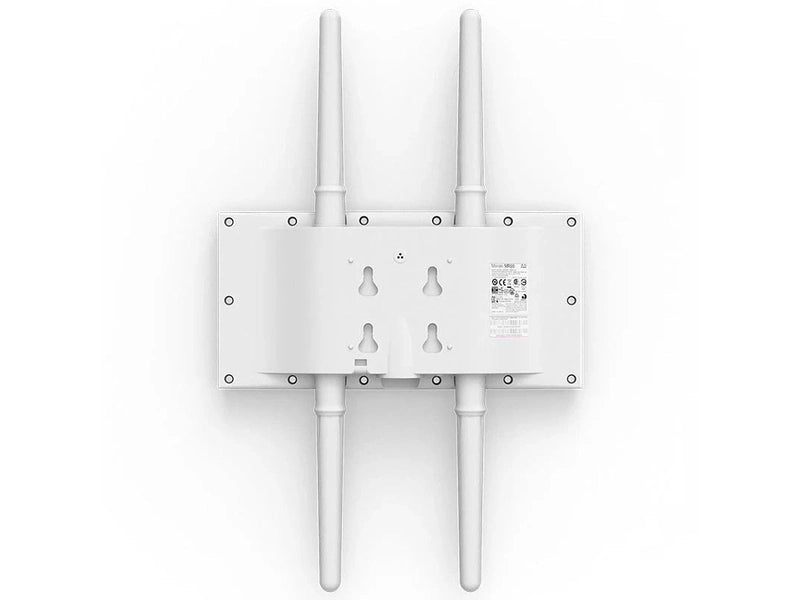Estimate shipping
High Performance 802.11ax Wireless
The Cisco Meraki MR86 is a cloud-managed 4x4:4 802.11ax access point that raises the bar for wireless performance and efficiency. Designed for next-generation deployments in offices, schools, hospitals, shops, and hotels, the MR86 offers high throughput, enterprise-grade security, and simple management.
The MR86 provides a maximum of 3.0 Gbps* aggregate frame rate with concurrent 2.4 GHz and 5 GHz radios. A dedicated third radio provides real-time WIDS/WIPS with automated RF optimization, and a fourth integrated radio delivers Bluetooth scanning and beaconing.
With the combination of
cloud management, high-performance hardware, multiple radios, and
advanced software features, the MR86 makes an outstanding platform for
the most demanding of uses—including high-density deployments and
bandwidth or performance-intensive applications like voice and
high-definition video.

MR86 and Meraki Cloud Management
Management of the MR86 is
performed through the Meraki cloud, with an intuitive browser-based
interface that enables rapid deployment without time-consuming training
or costly certifications. Because the MR86 is self-configuring and
managed over the web, it can be deployed at a remote location in a
matter of minutes, even without on-site IT staff.
24x7 monitoring via the Meraki cloud delivers real-time alerts if a
network encounters problems. Remote diagnostic tools enable immediate
troubleshooting over the web so that distributed networks can be managed
with a minimum of hassle.
The MR86’s firmware is automatically kept up to date via the cloud.
New features, bug fixes, and enhancements are delivered seamlessly over
the web. This means no manual software updates to download or missing
security patches to worry about.
Product Highlights
|
|
Features
Dual–radio aggregate frame rate of up to 3.0 Gbps*
5 GHz 4x4:4 and 2.4 GHz 4x4:4 radios offer a combined dual–radio aggregate frame rate of 3.0 Gbps*, with up to 2,402 Mbps in the 5 GHz band and 574 Mbps in the 2.4 GHz band.
* The radio chipset supports an aggregate PHY data rate of 3.5 Gbps (2,402 Mbps in the 5 GHz band and 1,147 Mbps in the 2.4 GHz band).
Note: Achieving a 1,147 Mbps PHY rate in 2.4GHz requires using 40MHz channels (20 + 20 MHz channel bonding) in 2.4GHz, which Cisco Meraki does not enable because this feature is not recommendable in real-world enterprise deployments. Please review this KB to learn more.
Multi User Multiple Input Multiple
Output (MU-MIMO)
With support for features of 802.11ax, the
MR86 offers MU-MIMO and OFDMA for more efficient transmission to
multiple clients. Especially suited to environments with numerous mobile
devices, MU-MIMO enables multiple clients to receive data
simultaneously. This increases the total network performance and
improves the end user experience.
Dedicated third radio delivers 24x7
wireless security and RF analytics
The MR86’s dedicated
dual-band scanning and security radio continually asses the environment,
characterizing RF interference and containing wireless threats like
rogue access points. There’s no need to choose between wireless
security, advanced RF analysis, and serving client data - a dedicated
third radio means that all functions occur in real-time, without any
impact to client traffic or AP throughput.
Bluetooth Low Energy Beacon and
scanning radio
An integrated fourth Bluetooth radio provides
seamless deployment of BLE Beacon functionality and effortless
visibility of Bluetooth devices. The MR86 enables the next generation of
location-aware applications while future proofing deployments, ensuring
it’s ready for any new customer engagement strategies.
Automatic cloud-based RF
optimization
The MR86’s sophisticated and automated RF
optimization means that there is no need for the dedicated hardware and
RF expertise typically required to tune a wireless network. The RF data
collected by the dedicated third radio is continuously fed back to the
Meraki cloud. This data is then used to automatically tune the channel
selection, transmit power, and client connection settings for optimal
performance under even the most challenging RF conditions.
Integrated enterprise security and
guest access
The MR86 features integrated, easy-to-use
security technologies to provide secure connectivity for employees and
guests alike. Advanced security features such as AES hardware-based
encryption and Enterprise authentication with 802.1X and Active
Directory integration provide wired-like security while still being easy
to configure. One-click guest isolation provides secure, Internet-only
access for visitors. PCI compliance reports check network settings
against PCI requirements to simplify secure retail deployments.
Enterprise Mobility Management
(EMM) & Mobile Device Management (MDM) integration
Meraki
Systems Manager natively integrates with the MR86 to offer automatic,
context-aware security. Systems Manager’s self-service enrollment helps
to rapidly deploy MDM without installing additional equipment, and then
dynamically tie firewall and traffic shaping policies to client posture.
Application-aware traffic shaping
The MR86 includes an integrated layer 7 packet inspection,
classification, and control engine, enabling the configuration of QoS
policies based on traffic type, helping to prioritize mission-critical
applications while setting limits on recreational traffic like
peer-to-peer and video streaming. Policies can be implemented per
network, per SSID, per user group, or per individual user for maximum
flexibility and control.
Voice and video optimizations
Industry standard QoS features are built-in and easy to configure.
Wireless MultiMedia (WMM) access categories, 802.1p, and DSCP standards
support all ensure important applications get prioritized correctly, not
only on the MR86, but on other devices in the network. Unscheduled
Automatic Power Save Delivery (U-APSD) and new Target Wait Time features
in 802.11ax clients ensure minimal battery drain on wireless VoIP
phones.
Self-configuring,
self-maintaining, always up-to-date
When plugged in, the
MR86 automatically connects to the Meraki cloud, downloads its
configuration, and joins the appropriate network. If new firmware is
required, this is retrieved by the AP and updated automatically. This
ensures the network is kept up-to-date with bug fixes, security updates,
and new features.
Advanced analytics
Drilling down into the details of network usage provides highly granular
traffic analytics. Visibility into the physical world can be enhanced
with journey tracking through location analytics. Visitor numbers, dwell
time, repeat visit rates, and track trends can all be easily monitored
in the dashboard and deeper analysis is enabled with raw data available
via simple APIs.
Specifications
| Category | Specifications |
| Radios |
|
| Antenna |
Antennas are not included, please see "Ordering Information" |
| 802.11ax, 802.11ac Wave 2 and 802.11n Capabilities |
Note: *40MHz channels are supported only in the 5GHz band.
|
| Power |
Note: Actual power consumption may vary depending on the AP usage. |
| Interfaces |
|
| Mounting |
|
| Physical Security |
|
| Environment |
|
| Reliability |
|
| Physical Dimensions |
|
| Security |
|
| Quality of Service |
|
| Mobility |
|
| Analytics |
|
| LED Indicators |
|
| Regulatory |
|
| Warranty |
|
| Ordering Information |
|
Compliance and Standards
| Category | Standards |
| IEEE Standards |
|
| Safety Approvals |
|
| Radio Approvals |
|
| EMI Approvals (Class B) |
|
| Exposure Approvals |
|
*** feature can be enabled for required networks
RF Performance Table
2.4 GHz
|
Operating Band |
Operating Mode |
Data Rate |
Total TX Power (conducted) |
RX Sensitivity per chain |
|
2.4 GHz |
802.11b |
1 Mb/s |
25.0 |
-99 |
|
2 Mb/s |
25.0 |
-95 |
||
|
5.5 Mb/s |
25.0 |
-93 |
||
|
11 Mb/s |
25.0 |
-90 |
||
|
2.4 GHz |
802.11g |
6 Mb/s |
25.0 |
-93 |
|
9 Mb/s |
25.0 |
-93 |
||
|
12 Mb/s |
23.5 |
-91 |
||
|
18 Mb/s |
23.5 |
-89 |
||
|
24 Mb/s |
22.0 |
-86 |
||
|
36 Mb/s |
22.0 |
-83 |
||
|
48 Mb/s |
21.5 |
-79 |
||
|
54 Mb/s |
21.5 |
-77 |
||
|
2.4 GHz |
802.11n (HT20) |
MCS0 |
25.0 |
-94 |
|
MCS1 |
25.0 |
-92 |
||
|
MCS2 |
23.5 |
-90 |
||
|
MCS3 |
23.5 |
-87 |
||
|
MCS4 |
23.5 |
-84 |
||
|
MCS5 |
21.5 |
-80 |
||
|
MCS6 |
21.5 |
-78 |
||
|
MCS7 |
20.5 |
-77 |
||
|
2.4 GHz |
802.11ac (VHT20) |
MCS0 |
25.0 |
-94 |
|
MCS1 |
25.0 |
-92 |
||
|
MCS2 |
23.5 |
-90 |
||
|
MCS3 |
23.5 |
-87 |
||
|
MCS4 |
23.5 |
-84 |
||
|
MCS5 |
21.5 |
-80 |
||
|
MCS6 |
21.5 |
-78 |
||
|
MCS7 |
20.5 |
-77 |
||
|
MCS8 |
19.5 |
-72 |
||
|
2.4 GHz |
802.11ax (HE20) |
MCS0 |
25.0 |
-94 |
|
MCS1 |
25.0 |
-92 |
||
|
MCS2 |
23.5 |
-90 |
||
|
MCS3 |
23.5 |
-87 |
||
|
MCS4 |
23.5 |
-84 |
||
|
MCS5 |
21.5 |
-79 |
||
|
MCS6 |
21.5 |
-78 |
||
|
MCS7 |
20.5 |
-76 |
||
|
MCS8 |
19.5 |
-72 |
||
|
MCS9 |
19.5 |
-71 |
||
|
MCS10 |
18.0 |
-67 |
||
|
MCS11 |
18.0 |
-65 |
5 GHz
|
Operating Band |
Operating Mode |
Data Rate |
TX Power |
RX Sensitivity |
|
5 GHz |
802.11a |
6 Mb/s |
24.0 |
-92 |
|
9 Mb/s |
24.0 |
-91 |
||
|
12 Mb/s |
23.0 |
-90 |
||
|
18 Mb/s |
23.0 |
-88 |
||
|
24 Mb/s |
22.0 |
-84 |
||
|
36 Mb/s |
22.0 |
-82 |
||
|
48 Mb/s |
21.0 |
-78 |
||
|
54 Mb/s |
20.5 |
-76 |
||
|
5 GHz |
802.11n (HT20) |
MCS0 |
24.0 |
-93 |
|
MCS1 |
24.0 |
-91 |
||
|
MCS2 |
23.0 |
-89 |
||
|
MCS3 |
23.0 |
-86 |
||
|
MCS4 |
22.0 |
-83 |
||
|
MCS5 |
22.0 |
-78 |
||
|
MCS6 |
21.0 |
-77 |
||
|
MCS7 |
20.5 |
-76 |
||
|
5 GHz |
802.11n (HT40) |
MCS0 |
23.0 |
-90 |
|
MCS1 |
23.0 |
-89 |
||
|
MCS2 |
23.0 |
-87 |
||
|
MCS3 |
23.0 |
-83 |
||
|
MCS4 |
22.0 |
-80 |
||
|
MCS5 |
21.0 |
-76 |
||
|
MCS6 |
20.5 |
-75 |
||
|
MCS7 |
20.0 |
-73 |
||
|
5 GHz |
802.11ac (VHT20) |
MCS0 |
24.0 |
-93 |
|
MCS1 |
24.0 |
-91 |
||
|
MCS2 |
23.0 |
-89 |
||
|
MCS3 |
23.0 |
-86 |
||
|
MCS4 |
22.0 |
-83 |
||
|
MCS5 |
22.0 |
-78 |
||
|
MCS6 |
21.0 |
-77 |
||
|
MCS7 |
20.5 |
-76 |
||
|
MCS8 |
19.5 |
-71 |
||
|
5 GHz |
802.11ac (VHT40) |
MCS0 |
23.0 |
-90 |
|
MCS1 |
23.0 |
-89 |
||
|
MCS2 |
23.0 |
-87 |
||
|
MCS3 |
23.0 |
-83 |
||
|
MCS4 |
22.0 |
-80 |
||
|
MCS5 |
21.0 |
-76 |
||
|
MCS6 |
20.5 |
-75 |
||
|
MCS7 |
20.0 |
-73 |
||
|
MCS8 |
19.0 |
-69 |
||
|
MCS9 |
18.5 |
-68 |
||
|
5 GHz |
802.11ac (VHT80) |
MCS0 |
23.0 |
-87 |
|
MCS1 |
23.0 |
-86 |
||
|
MCS2 |
23.0 |
-83 |
||
|
MCS3 |
23.0 |
-80 |
||
|
MCS4 |
22.0 |
-77 |
||
|
MCS5 |
20.0 |
-72 |
||
|
MCS6 |
20.0 |
-71 |
||
|
MCS7 |
19.0 |
-69 |
||
|
MCS8 |
18.0 |
-65 |
||
|
MCS9 |
18.0 |
-64 |
||
|
5 GHz |
802.11ax (HE20) |
MCS0 |
24.0 |
-93 |
|
MCS1 |
24.0 |
-91 |
||
|
MCS2 |
23.0 |
-89 |
||
|
MCS3 |
23.0 |
-86 |
||
|
MCS4 |
22.0 |
-83 |
||
|
MCS5 |
22.0 |
-78 |
||
|
MCS6 |
21.0 |
-77 |
||
|
MCS7 |
20.5 |
-75 |
||
|
MCS8 |
19.5 |
-71 |
||
|
MCS9 |
19.0 |
-70 |
||
|
MCS10 |
17.5 |
-67 |
||
|
MCS11 |
17.5 |
-65 |
||
|
5 GHz |
802.11ax (HE40) |
MCS0 |
23.0 |
-90 |
|
MCS1 |
23.0 |
-89 |
||
|
MCS2 |
23.0 |
-86 |
||
|
MCS3 |
23.0 |
-83 |
||
|
MCS4 |
22.0 |
-80 |
||
|
MCS5 |
21.0 |
-75 |
||
|
MCS6 |
20.5 |
-75 |
||
|
MCS7 |
20.0 |
-72 |
||
|
MCS8 |
19.0 |
-69 |
||
|
MCS9 |
18.5 |
-68 |
||
|
MCS10 |
17.0 |
-64 |
||
|
MCS11 |
17.0 |
-62 |
||
|
5 GHz |
802.11ax (HE80) |
MCS0 |
23.0 |
-87 |
|
MCS1 |
23.0 |
-85 |
||
|
MCS2 |
23.0 |
-83 |
||
|
MCS3 |
23.0 |
-80 |
||
|
MCS4 |
22.0 |
-77 |
||
|
MCS5 |
20.0 |
-72 |
||
|
MCS6 |
20.0 |
-72 |
||
|
MCS7 |
19.0 |
-69 |
||
|
MCS8 |
18.0 |
-67 |
||
|
MCS9 |
18.0 |
-65 |
||
|
MCS10 |
16.0 |
-61 |
||
|
MCS11 |
16.0 |
-59 |


